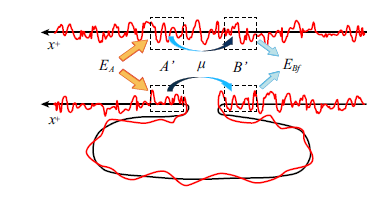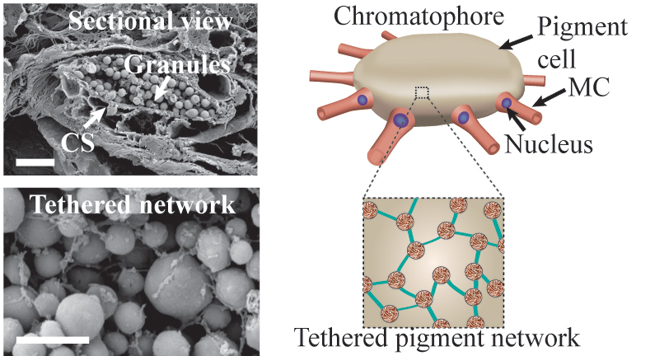Magnetic monopole
“A magnetic monopole is an isolated magnetic pole, magnetic charge, and a point-like source of magnetic field.”
An electron is a point-like particle that carries a so-called elementary electric charge. This means that an electron is an isolated source of an electric field.
Can a magnetic field have a similar point-like source?
Every one of us has likely held two bar magnets and noticed that their ends either attract or repel one another. The ends of the magnet are referred to as poles and every magnet has one end that is a north pole and one that is a south pole. A magnetic north pole attracts a magnetic south pole, but repels another north pole. In general, opposite poles attract, and identical poles repel. In this respect, magnetism is very much like electricity, which exhibits the same attractive and repulsive behavior involving positive and negative electric charges.
When a bar magnet breaks, two smaller bar magnets are created, each with its own north and south pole. You can break each of these smaller magnets in two, and so on, and every resulting magnet has a north pole and a south pole. Even at the atomic level, north and south poles always appear together. One cannot produce in this way a solitary pole, or monopole, that acts as a single point source of the magnetic field.
Are there other ways to find magnetic monopoles?
As yet, not a single natural magnetic monopole has been verifiably observed. This was initially considered to be a problem, because theoretical models that described the post-Big-Bang period predicted that they should be quite common. However, a special model for the expansion of the universe was developed that can explain the extreme rarity of these particles.
According to some theories, the energy content (mass) of a single magnetic monopole is so large that if it were completely used to recharge the battery of an electric car, this vehicle would be able to travel for kilometres with the energy. This explains why magnetic monopoles are probably not likely to occur in a particle accelerator. If the mass of a magnetic monopole really is that large, the energy released from the collision of a negatively and positively charged monopole would be as much as the energy released in the explosion of a kilogram of dynamite!
Dirac monopole
“A Dirac monopole is a point-like source of a possibly artificial magnetic field that forms at the endpoint of a quantum whirlpool.”
In quantum mechanics, an electron is described by a diffuse wave-like object rather than a point-like particle. Paul Dirac was the first person to understand the importance of studying the end points of quantum-mechanical whirlpools within these electron waves. He noticed that when an electron has such a terminating vortex, a magnetic monopole inevitably forms at the end point. A terminating vortex is the defining characteristic of the Dirac monopole.
Dirac also noticed that if the universe contains even a single magnetic monopole, it specifies the smallest possible value for an electric charge. All observed charges must be integer multiples of this minimum value; in other words, charge must be quantized. The existence of a monopole would therefore explain the experimental observation that electric charge is quantized.
Dirac monopoles are generally analyzed in a fairly simple quantum-mechanical model. Magnetic monopoles have since been studied in more general, so-called unified field theories, in which they could exist in the absence of a terminating vortex.
Synthetic magnetic field
“A synthetic magnetic field is an artificial field that leads to particle dynamics equivalent to those of an electric charge in a corresponding natural magnetic field.”
Electrons are not the only physical systems that can exhibit terminating vortices. Thus a Dirac monopole can also appear in other systems, such as the Bose-Einstein condensate. Rather than being related to the natural magnetic field, this monopole can be associated with a synthetic magnetic field. Importantly, the structure of the monopole is identical to that of a Dirac magnetic monopole. This is why the Dirac monopole observed in the synthetic magnetic field is closer to a natural magnetic monopole than any earlier observation.
Spin
“Roughly speaking, spin indicates how fast a particle is spinning around its own axis, and the orientation of that axis.”
Spin is a magnetic property of many particles, including electrons, protons, neutrons, and even many types of atoms. For example, the electron spin is composed of two basis states: up or down. This describes whether the electron is spinning around its axis in a clockwise or counter-clockwise direction.
A particle with a non-zero spin creates a magnetic field around it. However, this is not a monopole field – it is a so-called dipole field with both north and south magnetic poles, just like a bar magnet. Even this smallest of bar magnets cannot be broken into two separate magnetic monopoles.
In fact, bar magnets are composed of countless numbers of small spin dipoles, nearly all of which point in the same direction. Overlapping poles of different sign cancel out the field of each other, and thus the field of an ideal bar magnet looks as if it has magnetic poles only at its ends.
Spins tend to align along an externally applied magnetic field, which is the key to the creation of the synthetic magnetic monopole.
Synthesis of a monopole
“A monopole is created in a Bose–Einstein condensate by using an external magnetic field to guide the spins of the atoms forming the condensate.”
In 2009, Aalto University researchers Ville Pietilä and Mikko Möttönen published theoretical results demonstrating a method to create Dirac monopoles in a Bose–Einstein condensate. The idea involves using external magnetic fields to rotate the atomic spins. A Dirac monopole forms in the condensate as a result of the spin rotation. This method was adopted by the researchers in creating the synthetic magnetic monopole.
The Dirac monopole forms in the artificial magnetic field of the condensate, not in the physical magnetic field which steers the spin degree of freedom. Thus, a natural magnetic monopole is not needed to create the synthetic monopole.
Caption: Synthesis of a monopole in time, starting from panel a and ending with panel c. The arrows show the direction of the physical magnetic field produced in the laboratory. This magnetic field also directs the internal spin degree of freedom of the Bose–Einstein condensate in the direction of the arrows. The end result is that the condensate begins to move as if it were electrically charged and affected by a magnetic monopole in the position marked by the black circle in the image. Click for the full-resolution image.
The Bose–Einstein condensate
“A Bose–Einstein condensate behaves like a single giant atom, even though it can contain millions.”
A Bose–Einstein condensate is sometimes considered to be the fifth state of matter, in addition to solid, liquid, gas, and plasma. In the condensate, the importance and location of individual atoms becomes vague and the system behaves as if it were a single large atom. The first Bose–Einstein condensates were achieved in 1995, and this work received the Nobel Prize in 2001.
“Bose–Einstein condensates provide a window from our world into the quantum wonderland. The more often I peek at it, the more I want to stay there,” says enchanted Dr. Möttönen.
Since Bose–Einstein condensates contain many atoms, photographs of them can be taken using technology that is in part similar to that used in ordinary digital cameras. In addition, the condensates can be forced into the desired shape by means of external magnetic fields and laser beams. These properties make condensates a unique tool for developing new phenomena and quantum technologies. In addition to being used with magnetic monopoles, condensates can simulate the properties of various useful materials to the accuracy of a single atom. One of the daydreams of condensate researchers involves finding a solution for the development of superconducting materials that function at room temperature.
What in the world is quantum physics?
“Quantum physics describes natural phenomena most accurately.”
Quantum physics (also quantum mechanics) is a theory developed over the past 100 years that has been observed to describe the reality in more detail than any other model. It is particularly useful for explaining atomic-level phenomena, which is impossible using classical physics. On the other hand, quantum physics reproduces the same results as classical physics on the large scale.
In quantum mechanics, an electron can take on wave-like properties, sometimes appearing as an extended object rather than a point particle. It is this property of extension, which is shared with Bose-Einstein condensates, that permits the observation of the quantum whirlpools essential to detecting the effect of the magnetic monopole.
Quantum technologies use the laws of quantum physics relieved from classical restrictions to produce practical applications. For example, development of a quantum computer – a potentially super-fast problem solver – is one of the key goals of quantum technologies. A quantum computer would be able to find a solution to certain problems very quickly by using methods that are impossible in the logical framework of a normal computer.
“The laws of quantum physics make it possible to take shortcuts. Among other things, this is the basis of the super-fast speed of a quantum computer,” explains Möttönen.
Future directions
In the future, the research groups will concentrate on more in-depth research into the structure of a synthetic magnetic monopole. They are also interested in the dynamics of monopoles and their interactions with other synthetic particles. One interesting idea involves trying to create a monopole that is not bound to a whirlpool in the same way as is the Dirac monopole. This type of structure could possibly describe a natural magnetic monopole in even more detail.
Source: http://sci.aalto.fi/en/current/news/view/2014-01-29/
| 
















